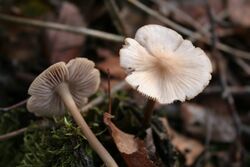Biology:Mycenaceae
| Mycenaceae | |
|---|---|

| |
| Mycena galericulata | |
| Scientific classification | |
| Domain: | Eukaryota |
| Kingdom: | Fungi |
| Division: | Basidiomycota |
| Class: | Agaricomycetes |
| Order: | Agaricales |
| Family: | Mycenaceae Overeem (1926) |
| Type genus | |
| Mycena (Pers.) Roussel (1806)
| |
| Genera | |
The Mycenaceae are a family of fungi in the order Agaricales. According to the Dictionary of the Fungi (10th edition, 2008), the family contains 10 genera and 705 species.[1] This is one of several families that were separated from the Tricholomataceae as a result of phylogenetic analyses. Taxa in the Mycenaceae are saprobic, have a cosmopolitan distribution, and are found in almost all ecological zones.[2] The family was circumscribed by Caspar van Overeem in 1926.
The extinct genus Protomycena, described from Burdigalian age Dominican amber found on the island of Hispaniola[3] is one of four known agaric genera in the fossil record.[4]
Phylogeny
| |||||||||||||||||||||||||||||||||||||||||||||||||||||||||||||||||||||||||||||||||||||||||||||||||||||||||||||||||||||
| Phylogeny of the Mycenaceae based on nuclear large ribosomal subunit gene sequences.[5] |
A large-scale phylogenetic analysis study of the Agaricales published by a consortium of mycologists in 2002 adopted the name Mycenaceae for a strongly supported clade consisting of Dictyopanus, Favolaschia, Mycena, Mycenoporella, Prunulus, Panellus, Poromycena, and Resinomycena.[5] Dictyopanus has since been wrapped into Panellus,[6] and both Poromycena[7] and Prunulus into Mycena.[8]
See also
References
- ↑ Kirk et al. (2008), p. 446.
- ↑ Fungal Families of the World. Wallingford, UK: CAB International. 2007. pp. 225–26. ISBN 978-0-85199-827-5.
- ↑ "Fossil mushrooms from Miocene and Cretaceous ambers and the evolution of Homobasidiomycetes". American Journal of Botany 84 (8): 981–91. 1997. doi:10.2307/2446289.
- ↑ "Another fossil agaric from Dominican amber". Mycologia 95 (4): 685–87. 2003. doi:10.2307/3761943. PMID 21148976. http://www.mycologia.org/cgi/content/full/95/4/685.
- ↑ 5.0 5.1 "One hundred and seventeen clades of euagarics". Molecular Phylogenetics and Evolution 23 (3): 357–400. 2002. doi:10.1016/S1055-7903(02)00027-1. PMID 12099793.
- ↑ Kirk et al. (2008), p. 206.
- ↑ Kirk et al. (2008), p. 559.
- ↑ Kirk et al. (2008), p. 565.
Cited text
- Dictionary of the Fungi (10th ed.). Wallingford, UK: CAB International. 2008. p. 446. ISBN 978-0-85199-826-8.
Wikidata ☰ Q3116124 entry
 |

